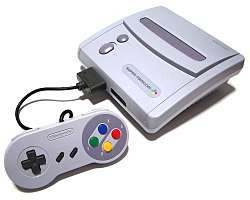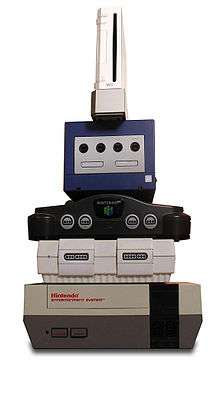New-Style Super NES
The New-Style Super NES[2] (also known by its model number SNS-101[3]) is a compact redesign of the original Super Nintendo Entertainment System video game console released by Nintendo in 1997. In Japan, the system is called the Super Famicom Jr. (Japanese: スーパーファミコン ジュニア, Hepburn: Sūpā Famikon Junia). Like the redesigned version of the original Nintendo Entertainment System before it, the new-style Super NES was released late during the platform's lifespan.
  | |
  Top: New-Style Super NES Bottom: Super Famicom Jr. | |
| Also known as |
|
|---|---|
| Manufacturer | Nintendo |
| Type | Home video game console |
| Generation | Fourth generation |
| Release date | |
| Introductory price | JP¥7,800 US$99.95 |
| Discontinued | |
| Media | ROM Cartridge |
| CPU | Ricoh 5A22 @ 3.58 MHz |
| Sound | Nintendo S-SMP |
Background
The New-Style Super NES was designed by Lance Barr, who previously designed the North American versions of the NES, and Super NES, as well as the redesigned NES.[4] Released at a lower price point, Nintendo marketed it as an entry-level gamer's system[5] for customers who were on a budget and who may have been put off by the higher price of other more modern systems such as the Nintendo 64, Sega Saturn and PlayStation. Nintendo marketed the system in North America simply as the "Super Nintendo Entertainment System", just as the company had done the original SNS-001 model. It was released in North America on October 20, 1997[3] and retailed for US$99.95.[6] The system was available as a stand-alone package or in a variety of bundles, each including one pack-in game such as:
- Super Mario World 2: Yoshi's Island[7]
- The Legend of Zelda: A Link to the Past (Target exclusive)
- Kirby Super Star (Target exclusive)
- Tetris Attack (Toys "R" Us exclusive)
The system was released in Japan as the Super Famicom Jr. on March 27, 1998 and retailed for ¥7,800.[8] It was given the model number SHVC-101 and is very similar to the New-Style Super NES in both appearance and functionality. It was manufactured until September 2003.[9]
Hardware changes

The design of the SNS-101 is a large departure from that of the North American version of the original Super NES. The system features a smaller footprint than the older model and contains a much less angular design language. To reach an affordable price point, several features were removed. The system lacks the expansion slot on the bottom of the console featured on the SNS-001, making it incompatible with the Japan-exclusive Satellaview add-on. The power and reset buttons were moved to the left hand side, and the cartridge eject button has been removed entirely. Additionally, it lacks a power LED to indicate when the unit is on. The internal RF modulator was also removed; however, an external RF modulator can be used.[2]
The SNS-101 features the same AV multi-out port used on the original model.[10] However, the SNS-101 only supports composite video through this port, whereas the SNS-001 supported composite video, S-Video and RGB. The video encoder used in the system still supports S-Video and RGB, but these pins were left unused. Users are able to modify the system to restore the removed functionality,[11][12] and is considered to be an improvement of video quality over earlier revisions of the SNES.[13]
The included controller underwent slight changes and was given a new model number (SNS-102). The "Super Nintendo Entertainment System" marking on the front was replaced by a general Nintendo logo molded into the casing. In fact, the Japanese controller also underwent this same change and actually shares the same model number as its U.S. counterpart, as the back of the controller has both, the Super NES and Super Famicom logos. Despite this, the colors and shapes of the ABXY buttons still differed between regions.
See also
- Nintendo Entertainment System (Model NES-101)
- Wii Mini
References
- Don Reisinger (January 21, 2009). "Does the Xbox 360's 'Lack of Longevity' Matter?". CNET. Retrieved October 23, 2015.
- "Nintendo Support: New-Style Super NES RF to TV Hookup". Nintendo. Retrieved March 2, 2010.
- "SNS-101". Retrieved February 21, 2009.
- Chad Margetts & M. Noah Ward (May 31, 2005). "Lance Barr Interview". Nintendojo. Retrieved March 2, 2013.
- Ohbuchi, Yutaka (January 16, 1998). "Super Fami Gets Face-Lift". GameSpot. Retrieved February 21, 2009.
- Johnston, Chris (October 29, 1997). "Super NES Lives!". GameSpot. Retrieved February 21, 2009.
- "Yoshi's Island Package Shot". Archived from the original on May 18, 2013. Retrieved February 21, 2009.CS1 maint: BOT: original-url status unknown (link)
- "Nintendo Japan - Super Famicom Jr page". Retrieved February 21, 2009.
- Niizumi, Hirohiko (May 30, 2003). "Nintendo to end Famicom and Super Famicom production". GameSpot. Retrieved January 11, 2014.
- "Nintendo Support: Super NES AV to TV Hookup". Nintendo. Retrieved March 2, 2010.
- "SNESjr RGB Mod". Retrieved February 21, 2009.
- "SNES Mini RGB Mods | RetroRGB".
- "SNES Version Compare | RetroRGB".
External links
![]()


